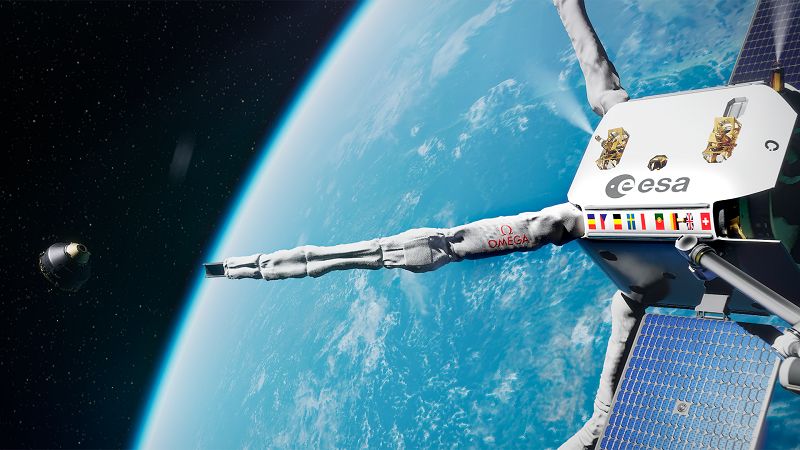[ad_1]
How to find debris in space? Start-ups have positioned themselves on the issue in order to offer cleaning solutions. We spoke with one of the most advanced, the Swiss ClearSpace. Interview with its co-founder, Muriel Richard-Noca.
Space debris can cause serious damage in space and their number poses a problem for future missions in orbit. Start-ups have been working on cleaning solutions for years. This is the case of the Swiss ClearSpace which will carry out its first mission of removal of debris weighing more than 110 kg. The launch is planned for the second half of 2026 aboard Arianespace’s Vega C launcher. To understand how such technology works, we spoke with Muriel Richard-Noca, chief engineer and co-founder of the Swiss start-up ClearSpace.
Engineering techniques: Can you tell us how the ClearSpace adventure began?
Muriel Richard-Noca : It all started at the École Polytechnique Fédérale de Lausanne (EPFL) in Switzerland. The EPFL space center – eSpace Center – had initiated and supervised, with the help of the Universities of Applied Sciences (HES), a student project to create a small satellite, the Cubesat SwissCube. We carried out this project between 2006 and 2009. At the end of these three years, we launched our Cubesat, on board an Indian rocket, to an altitude of approximately 720 km from the Earth’s surface. A nearby altitude, and one of the busiest. But at the time, we were not aware of the problems posed by debris. We discovered it and experienced it in operation, when we received numerous notifications from the American Air Force on the upcoming collisions. The frequency of messages was such that we became aware of the problem. Especially since we were in a region which had experienced two collisions shortly before. Today, we avoid selecting these orbits.
Thanks to this awareness, you then decided to work on a solution…
Effectively. At EPFL, we created a research and development program to define how we were going to remove this debris. We did this in particular through student projects, by carrying out prototypes and tests, which allowed us to increase our understanding. We studied the robotic arms, gecko-type adhesive surfaces, sending a net… After a while, a solution appeared to us, the most logical and the simplest: a system of simplified robotic arms, like tentacles, with a closed volume in which the debris is enclosed. And beyond the robotic technical solution, it was important to us to consider a global system and a service offering including the design of the robot satellite, the ground segment and in-flight operations.
It is also to develop and market this solution that we created ClearSpace. Initially, we had a small budget at the university of 10,000 euros per year to create prototypes and test systems. We couldn’t find bigger funding, because we had to show an interesting business (commercial) model. The EPFL laboratories and space center continued to help us on sensitive and complex technological points.
Today, your technology has been selected by the ESA to search for debris in space. When did you become interested in space players?
It was in 2016, with the arrival of “megaconstellations”: several companies received licenses to launch several thousand satellites into orbit in order to provide a global internet service. These are these satellite constellations [et la question de leur fin de vie, ndlr] which paved the way for a business model for space debris removal. And in fact, ClearSpace was selected by the European Space Agency (ESA) to remove one of their debris. This demonstration will allow us to create the demonstrator for our tow truck. And once demonstrated at a viable cost – a very important point – it will then be possible to consider being called for this service.

How does this space tow truck work?
It is an autonomous space robot – a robot satellite – designed to intercept debris rotating uncontrollably in space at a certain Earth speed. How do I catch it before impact? This is the challenge of our capture and navigation system, based on image and movement recognition, as well as a guidance system for the approach. In fact, we need an autonomous system in space that can reconstruct the movement of the object, approach and reconstruct this movement. From that moment on, he determines a trajectory, initiates its own movement to capture and stabilize the debris. Once stabilized, the object can be returned to the Earth’s atmosphere.
And for our first mission, we deliberately planned a time-consuming process. Our objective is to validate all hypotheses upstream and to progress step by step. We will integrate different sensor technologies, such as infrared or lidar cameras, in order to define the best approach. We will take our time to ensure a complete understanding of each step and confirm the solidity of our design.
Will this robot have its own mission or will it be integrated into another space mission?
It’s a mix of both. The robot could be integrated into an existing mission, for example, into a rocket which could fetch debris if it has energy left. But a priori, for its first mission, it will be specifically designed to recover a single object. We are also collaborating with the Great Britain Space Agency on a mission this time aimed at recovering two pieces of debris. Each of these missions is a demonstration that increases technological capability and assurance of implementation. In short, we demonstrate the quality and reliability of our technology. The missions are planned for 2026 and we will be able to launch the commercial version once the first mission has been completed.
[ad_2]
Source link